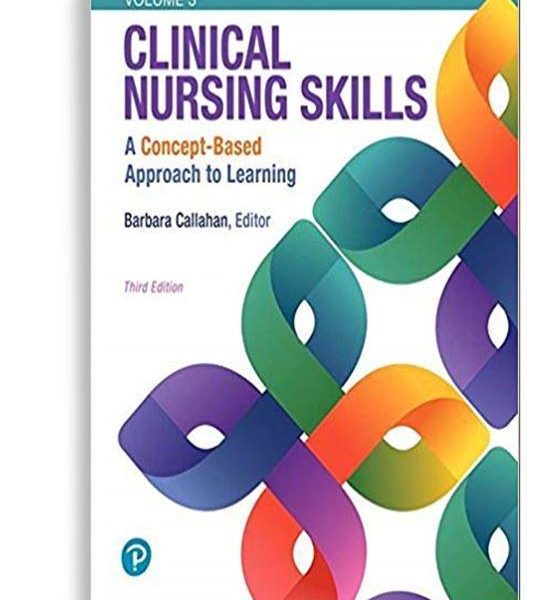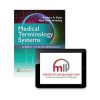Test Bank For Clinical Nursing Skills: A Concept-Based Approach, Volume Iii 3rd Edition By Barbara Callahan
$35.00 Original price was: $35.00.$26.50Current price is: $26.50.
Test Bank For Clinical Nursing Skills: A Concept-Based Approach, Volume Iii 3rd Edition By Barbara Callahan
Instant download Test Bank For Clinical Nursing Skills: A Concept-Based Approach, Volume Iii 3rd Edition By Barbara Callahan pdf docx epub after payment.

Product details:
- ISBN-10 : 0134616839
- ISBN-13 : 978-0134616834
- Author: Barbara Callahan
Nursing: A Concept-Based Approach to Learning provides all of the core content and materials needed to deliver an effective concept-based program that develops practice-ready nurses. This three-volume series is the only concepts curriculum developed from the ground up as a cohesive, comprehensive learning system. An intentional instructional design and learning pattern fosters connections between concepts and a deep level of comprehension that can be applied broadly. Volume III, Clinical Skills: A Concept-Based Approach, presents more than 275 key nursing skills, with 250 minor skills embedded within them, that complement concepts in the first two volumes and support a concept-based approach. The 3rd edition of Volume III is a full-scale, cover-to-cover revision that brings the text in line with new evidence-based practice, care, and safety guidelines.
Table of contents:
- Chapter at a Glance
- General Assessment
- 1.1 Appearance and Mental Status: Assessing
- 1.2 Height: Newborn, Infant, Child, Adult, Measuring
- 1.3 Newborn’s or Infant’s Head, Chest, and Abdomen: Measuring
- 1.4 Weight: Newborn, Infant, Child, Adult, Measuring
- Vital Signs
- 1.5 Blood Pressure: Newborn, Infant, Child, Adult, Obtaining
- 1.6 Pulse, Apical and Peripheral: Obtaining
- 1.7 Pulse Oximeter: Using
- 1.8 Respirations: Newborn, Infant, Child, Adult, Obtaining
- 1.9 Temperature: Newborn, Infant, Child, Adult, Obtaining
- Physical Assessment
- 1.10 Abdomen: Assessing
- 1.11 Anus: Assessing
- 1.12 Breasts and Axillae: Assessing
- 1.13 Ears: Hearing Acuity, Assessing
- 1.14 Eyes: Visual Acuity, Assessing
- 1.15 Genitals and Inguinal Area: Assessing
- 1.16 Hair: Assessing
- 1.17 Heart and Central Vessels: Assessing
- 1.18 Mouth and Oropharynx: Assessing
- 1.19 Musculoskeletal System: Assessing
- 1.20 Nails: Assessing
- 1.21 Neck: Assessing
- 1.22 Neurologic Status: Assessing
- 1.23 Nose and Sinuses: Assessing
- 1.24 Peripheral Vascular System: Assessing
- 1.25 Skin: Assessing
- 1.26 Skull and Face: Assessing
- 1.27 Thorax and Lungs: Assessing
- Critical Thinking Options for Unexpected Outcomes
- Review Questions
- Chapter at a Glance
- Bed Care and Activities of Daily Living (ADLs)
- 2.1 Bathing: Newborn, Infant, Child, Adult
- 2.2 Bedmaking: Occupied, Unoccupied
- 2.3 Eyes and Contact Lenses: Caring for
- 2.4 Feet: Caring for
- 2.5 Hair: Caring for
- 2.6 Hearing Aid: Removing, Cleaning, and Inserting
- 2.7 Mouth: Regular and for the Unconscious or Debilitated Patient, Caring for
- 2.8 Perineal-Genital Area: Caring for
- 2.9 Shaving: Male Patient
- Medication and Administration Systems
- 2.10 Automated Dispensing System: Using
- 2.11 Medication: Preparing and Administering
- 2.12 Narcotic Control System: Using
- Medication Preparation
- 2.13 Ampule Medication: Removing
- 2.14 Calculating Dosages
- 2.15 Mixing Medications in One Syringe
- 2.16 Vial Medication: Removing
- Medication Routes
- 2.17 Ear Medication: Administering
- 2.18 Enteral Tube Medication: Administering
- 2.19 Eye Medication: Administering
- 2.20 Inhaler, Dry Powder Medication: Administering
- 2.21 Inhaler, Metered-Dose Medication: Administering
- 2.22 Nasal Medication: Administering
- 2.23 Nebulized Medication, Nonpressurized Aerosol (NPA): Administering
- 2.24 Oral Medication: Administering
- 2.25 Rectal Medication: Administering
- 2.26 Sublingual Medication: Administering
- 2.27 Topical Medication: Applying
- 2.28 Transdermal Patch Medication: Applying
- 2.29 Vaginal Medication: Administering
- Parenteral Routes
- 2.30 Injection, Intradermal: Administering
- 2.31 Injection, Intramuscular: Administering
- 2.32 Injection, Subcutaneous: Administering
- 2.33 Injection, Subcutaneous Anticoagulant: Administering
- 2.34 Injection, Z-Track Method: Using
- 2.35 Insulin Injection: Using a Syringe, Pen, or Pump
- 2.36 Intravenous Medication: Adding to Fluid Container
- 2.37 Intravenous Medication, Intermittent: Using a Secondary Set
- 2.38 Intravenous Medication, IV Push: Administering
- Critical Thinking Options for Unexpected Outcomes
- Review Questions
- Chapter at a Glance
- Acute/Chronic Pain Management
- 3.1 Pain in Newborn, Infant, Child, Adult: Assessing
- 3.2 Pain Relief: Back Massage
- 3.3 Pain Relief: Complementary Health Approaches
- 3.4 Pain Relief: Transcutaneous Electrical Nerve Stimulation (TENS) Unit, Using
- 3.5 Patient-Controlled Analgesia (PCA) Pump: Using
- 3.6 Sleep Promotion: Assisting
- Heat and Cold Application
- 3.7 Cooling Blanket: Applying
- 3.8 Dry Cold: Applying
- 3.9 Dry Heat: Applying
- 3.10 Moist Pack and Tepid Sponges: Applying
- 3.11 Neonatal Incubator and Infant Radiant Warmer: Using
- 3.12 Sitz Bath: Assisting
- End of Life Care
- 3.13 Physiological Needs of the Dying Patient: Managing
- 3.14 Postmortem Care: Providing
- Critical Thinking Options for Unexpected Outcomes
- Review Questions
- Chapter at a Glance
- Assessment — Collecting Specimens
- 4.1 Bladder Scanner: Using
- 4.2 Stool Specimen, Routine, Culture, Ova, Parasites: Obtaining
- 4.3 Urine Specimen, Clean-Catch, Closed Drainage System for Culture and Sensitivity: Obtaining
- 4.4 Urine Specimen, Ileal Conduit: Obtaining
- 4.5 Urine Specimen, Routine, 24-Hour: Obtaining
- Bladder Interventions
- 4.6 Bedpan: Assisting
- 4.7 Bladder Irrigation: Continuous
- 4.8 Bladder Irrigation: Providing
- 4.9 Commode: Assisting
- 4.10 Urinal: Assisting
- 4.11 Urinary Catheter: Caring for and Removing
- 4.12 Urinary Catheterization: Performing
- 4.13 Urinary Diversion Pouch: Applying
- 4.14 Urinary External Device: Applying
- 4.15 Urinary Ostomy: Caring for
- 4.16 Urinary Suprapubic Catheter: Caring for
- Bowel Interventions
- 4.17 Bowel Routine, Develop Regular: Assisting
- 4.18 Bowel Diversion Ostomy Appliance: Changing
- 4.19 Colostomy: Irrigating
- 4.20 Enema and Retention Enema: Administering
- 4.21 Fecal Impaction: Removing
- 4.22 Fecal Ostomy Pouch: Applying
- 4.23 Rectal Tube: Inserting
- Dialysis
- 4.24 Dialysis, Peritoneal: Catheter Insertion, Assisting
- 4.25 Dialysis, Peritoneal: Procedures, Assisting
- 4.26 Hemodialysis: Central Venous Dual-Lumen Catheter, Caring for
- 4.27 Hemodialysis: Procedures, Caring for, Assisting
- Critical Thinking Options for Unexpected Outcomes
- Review Questions
- Chapter at a Glance
- Fluid Balance Measurement
- 5.1 Intake and Output: Measuring
- Intravenous Therapy
- 5.2 Central Line Dressing: Changing
- 5.3 Central Line: Infusing Intravenous Fluids
- 5.4 Central Line: Managing
- 5.5 Implanted Vascular Access Devices: Managing
- 5.6 Infusion Device: Discontinuing
- 5.7 Infusion Flow Rate Using Controller or IV Pump: Regulating
- 5.8 Infusion Intermittent Device: Maintaining
- 5.9 Infusion: Initiating
- 5.10 Infusion: Maintaining
- 5.11 Infusion Pump and “Smart” Pump: Using
- 5.12 Infusion Syringe Pump: Using
- 5.13 Percutaneous Central Vascular Catheterization: Assisting
- 5.14 PICC Line Dressing: Changing
- 5.15 Venipuncture: Initiating
- Critical Thinking Options for Unexpected Outcomes
- Review Questions
- Chapter at a Glance
- Medical Asepsis
- 6.1 Hand Hygiene: Performing
- Person Protective Equipment (PPE) and Isolation Precautions
- 6.2 Enteric Contact Precautions: Using
- 6.3 Isolation, Attire: Donning and Doffing
- 6.4 Isolation, Patient and Others: Caring for
- 6.5 Isolation, Double-Bagging: Using
- 6.6 Isolation, Equipment, Specimens: Removing
- 6.7 Isolation, Transporting Patient Outside Room
- 6.8 PPE, Clean Gloves: Donning and Doffing
- 6.9 PPE, Face Masks: Donning and Doffing
- Critical Thinking Options for Unexpected Outcomes
- Review Questions
- Chapter at a Glance
- 7.1 Glasgow Coma Scale: Using
- 7.2 Intracranial Pressure: Monitoring and Caring for
- 7.3 Lumbar Puncture: Assisting
- Critical Thinking Options for Unexpected Outcomes
- Review Questions
- Chapter at a Glance
- General
- 8.1 Endocrine Disorders: Assessing
- 8.2 Endocrine Disorders: Complementary Health Approaches
- 8.3 Paracentesis: Assisting
- Diabetes Care
- 8.4 Capillary Blood Specimen for Glucose: Measuring
- 8.5 Diabetes: Managing
- Critical Thinking Options for Unexpected Outcomes
- Review Questions
- Chapter at a Glance
- Balance and Strength
- 9.1 Body Mechanics: Using
- 9.2 Range-of-Motion Exercises: Assisting
- Moving and Transferring a Patient
- 9.3 Ambulating Patient: Assisting
- 9.4 Hydraulic Lift: Using
- 9.5 Logrolling Patient in Bed
- 9.6 Moving Patient Up in Bed
- 9.7 Positioning Patient in Bed
- 9.8 Sitting on Side of Bed (Dangling): Assisting
- 9.9 Transferring Patient Between Bed and Chair
- 9.10 Transferring Patient Between Bed and Stretcher
- 9.11 Transporting: Newborn, Infant, Toddler
- 9.12 Turning Patient: Lateral or Prone Position in Bed
- Patient Assistive Devices
- 9.13 Cane: Assisting
- 9.14 Crutches: Assisting
- 9.15 Walker: Assisting
- Traction and Cast Care
- 9.16 Cast, Initial: Caring for
- 9.17 Cast, Ongoing for Plaster and Synthetic: Caring for
- 9.18 Traction, Skin and Skeletal: Caring for
- Critical Thinking Options for Unexpected Outcomes
- Review Questions
- Chapter at a Glance
- Healthy Eating Habits
- 10.1 Body Mass Index (BMI): Assessing
- 10.2 Diet, Therapeutic: Managing
- 10.3 Eating Assistance: Providing
- 10.4 Mealtime: Complementary Health Approaches
- 10.5 Nutrition: Assessing
- Enteral Nutrition Using a Feeding Tube
- 10.6 Feeding, Continuous, Nasointestinal/Jejunostomy with a Small-Bore Tube: Administering
- 10.7 Feeding, Gastrostomy or Jejunostomy Tubes: Administering
- 10.8 Gastric Lavage: Performing
- 10.9 Nasogastric Tube: Feeding
- 10.10 Nasogastric Tube: Flushing and Maintaining
- 10.11 Nasogastric Tube: Inserting
- 10.12 Nasogastric Tube: Removing
- Parenteral Nutrition Using Intravenous Infusion
- 10.13 Lipids, IV Infusion: Providing
- 10.14 Total Parental Nutrition (TPN), IV Infusion: Providing
- Critical Thinking Options for Unexpected Outcomes
- Review Questions
- Chapter at a Glance
- Assessment
- 11.1 Nose and Throat Specimen: Collecting
- 11.2 Peak Expiratory Flow Rate: Measuring
- 11.3 Sputum Specimen: Collecting
- Interventions
- 11.4 Chest Physiotherapy: Preparing Patient
- 11.5 Incentive Spirometer: Using
- 11.6 Pursed-Lip Breathing
- 11.7 Thoracentesis: Assisting
- Supplemental Oxygen Therapy
- 11.8 Oxygen Delivery Systems: Using
- 11.9 Oxygen, Portable Cylinder: Using
- 11.10 Ventilator, Mechanical: Caring for Patient
- Maintaining a Patent Airway
- 11.11 Airway, Nasopharyngeal: Inserting
- 11.12 Airway, Oropharyngeal: Inserting
- 11.13 Endotracheal Tube: Caring for
- 11.14 Suctioning, Oropharyngeal and Nasopharyngeal: Newborn, Infant, Child, Adult
- 11.15 Suctioning, Tracheostomy or Endotracheal Tube
- 11.16 Tracheal Tube: Inflating the Cuff
- 11.17 Tracheostomy: Caring for
- Maintaining Lung Expansion
- 11.18 Chest Tube Drainage: Maintaining
- 11.19 Chest Tube Insertion: Assisting
- 11.20 Chest Tube Removal: Assisting
- Life Threatening Situations
- 11.21 Airway Obstruction: Clearing
- 11.22 Cardiac Compressions, External: Performing
- 11.23 Rescue Breathing: Performing
- Critical Thinking Options for Unexpected Outcomes
- Review Questions
- Chapter at a Glance
- Maintaining Blood Volume
- 12.1 Blood Products: Administering
- 12.2 Blood Transfusion: Administering
- 12.3 Direct Pressure: Applying
- 12.4 Pressure Dressing: Applying
- Antiembolism Devices
- 12.5 Antiembolism Stockings: Applying
- 12.6 Pneumatic Compression Device: Applying
- 12.7 Sequential Compression Devices: Applying
- Electrical Conduction in the Heart
- 12.8 Automated External Defibrillator (AED): Adult, Using
- 12.9 ECG, 12-Lead: Recording
- 12.10 ECG, Leads: Applying
- 12.11 ECG, Strip: Interpreting
- 12.12 Pacemaker, Insertion: Assisting
- 12.13 Pacemaker, Permanent: Teaching
- 12.14 Pacemaker, Temporary: Maintaining
- 12.15 Temporary Cardiac Pacing, Transvenous, Epicardial: Monitoring
- Arterial Line
- 12.16 Allen Test: Performing
- 12.17 Arterial Blood Pressure: Monitoring
- 12.18 Arterial Blood Samples: Withdrawing
- 12.19 Arterial Line: Caring for
- Critical Thinking Options for Unexpected Outcomes
- Review Questions
- Chapter at a Glance
- General
- 13.1 Preoperative Patient Teaching
- 13.2 Surgical Hand Antisepsis and Scrubs
- 13.3 Surgical Site: Preparing
- Using Sterile Technique
- 13.4 Sterile Field: Maintaining
- 13.5 Sterile Gown and Gloves: Donning (Closed Method)
- 13.6 Surgical Patient: Preparing
- Critical Thinking Options for Unexpected Outcomes
- Review Questions
- Chapter at a Glance
- Antepartum Care
- 14.1 Amniocentesis: Assisting
- 14.2 Antepartum, Maternal and Fetal: Assessing
- 14.3 Antepartum Pelvic Examination: Assisting
- 14.4 Deep Tendon Reflexes and Clonus: Assessing
- 14.5 Fetal Well-Being, Nonstress Test and Biophysical Profile: Assessing
- 14.6 Rh Immune Globulin: Administering
- Intrapartum Care
- 14.7 Amniotomy (Artificial Rupture of Membranes): Assisting
- 14.8 Epidural: Assisting and Caring for Patient
- 14.9 Fetal External Electronic: Monitoring
- 14.10 Fetal Heart Rate: Auscultating
- 14.11 Fetal Internal Scalp Electrode Placement: Monitoring
- 14.12 Induction of Labor with Oxytocin and Other Agents: Assisting and Caring for Patient
- 14.13 Intrapartum, Maternal and Fetal: Assessing
- 14.14 Intrapartum Pelvic Examination: Assisting
- 14.15 Prolapsed Cord: Caring for Patient
- Postpartum Care
- 14.16 Breastfeeding: Assisting
- 14.17 Lochia: Evaluating
- 14.18 Postpartum, Maternal: Assessing
- 14.19 Postpartum, Perineum: Assessing
- 14.20 Uterine Fundus, After Vaginal or Caesarean Birth: Assessing
- Newborn Care
- 14.21 Apgar Score: Assessing
- 14.22 Circumcision: Caring for
- 14.23 Newborn: Assessing
- 14.24 Newborn, Initial Bathing
- 14.25 Newborn Thermoregulation: Assisting
- 14.26 Phototherapy, Newborn, Infant: Providing
- 14.27 Umbilical Cord Clamp: Caring for
- Critical Thinking Options for Unexpected Outcomes
- Review Questions
- Chapter at a Glance
- Patient Safety
- 15.1 Abuse: Newborn, Infant, Child, Older Adult, Assessing for
- 15.2 Fall Prevention: Assessing and Managing
- 15.3 Seizure Precautions: Implementing
- 15.4 Suicide: Caring for Suicidal Patient
- Environmental Safety
- 15.5 Environmental Safety: Healthcare Facility, Community, Home
- 15.6 Fire Safety: Healthcare Facility, Community, Home
- 15.7 Thermal and Electrical Injuries: Preventing
- Immobilizers and Restraints
- 15.8 Bed or Chair Alarm, Exit Monitor Device: Applying
- 15.9 Immobilizer, Mummy: Applying
- 15.10 Immobilizer, Papoose Board: Applying
- 15.11 Restraints and Alternatives: Caring for
- 15.12 Restraints, Torso and Belt: Applying
- 15.13 Restraints, Wrist and Ankle: Applying
- Critical Thinking Options for Unexpected Outcomes
- Review Questions
- Chapter at a Glance
- Assessment
- 16.1 Wound Drainage Specimen: Obtaining
- Dressings and Binders
- 16.2 Abdominal Binder: Applying
- 16.3 Closed Wound Drains: Maintaining
- 16.4 Dressing, Dry: Changing
- 16.5 Dressing, Sterile: Changing
- 16.6 Dressing, Venous Ulcer: Changing
- 16.7 Dressing, Wet-to-Moist: Applying
- 16.8 Elastic Bandage: Applying
- 16.9 Surgical Wound: Caring for
- Wound Care
- 16.10 Dressing, Alginate: Applying
- 16.11 Dressing, Hydrocolloid: Applying
- 16.12 Dressing, Transparent: Applying
- 16.13 Electrical Stimulation: Using
- 16.14 Negative Pressure Wound Therapy: Using
- 16.15 Pressure Injury: Preventing and Caring for
- 16.16 Staple and Suture: Removing
- 16.17 Stump: Positioning and Exercising
- 16.18 Stump: Shrinking and Molding
- 16.19 Wound: Irrigating
- Critical Thinking Options for Unexpected Outcomes
- Review Questions
People also search:
Clinical Nursing Skills: A Concept-Based Approach, Volume Iii 3rd Edition
Clinical Nursing Skills: A Concept-Based Approach, Volume Iii 3rd Edition pdf
Clinical Nursing Skills: A Concept-Based Approach
what are clinical skills in nursing
what is concept based learning in nursing
what is a concept nursing
Related products
Test Bank
Test Bank for Clinical Immunology and Serology A Laboratory Perspective, 3rd Edition: Stevens
Test Bank
Test Bank for Operating Systems: Internals and Design Principles, 7th Edition: William Stallings











